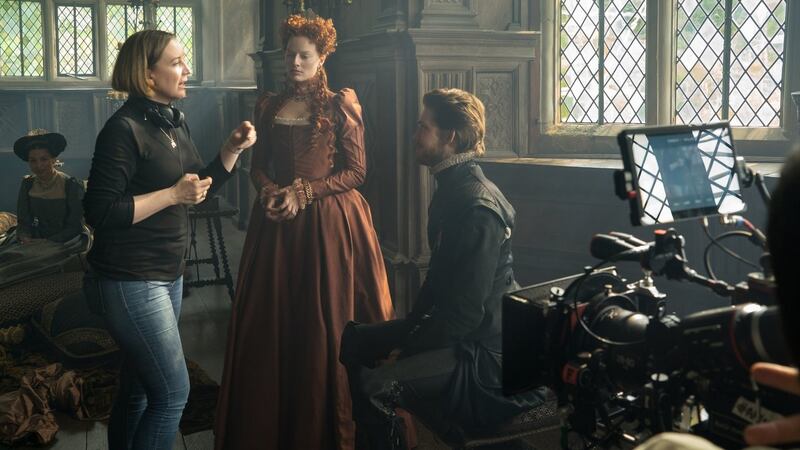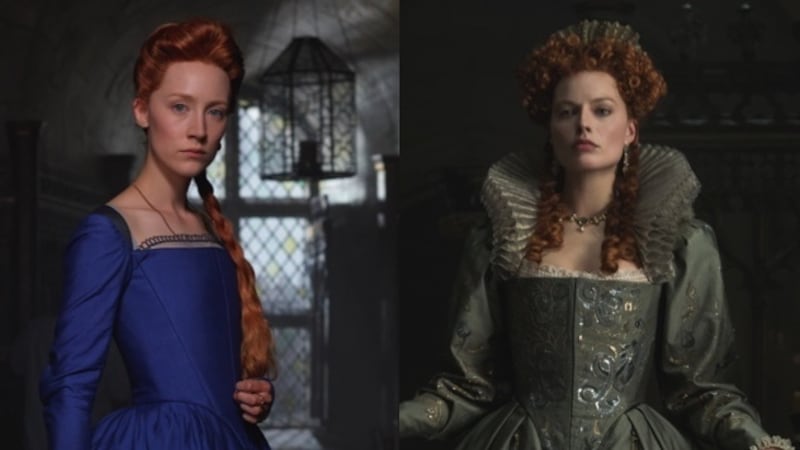Josie Rourke kicks off her heels and sums up her current punishing schedule with the words: "Bouts of talking about myself, punctuated by having my hair done." We are in a grand London hotel, where Rourke is stationed to publicise her debut feature film. "The only point of reference I have for all this is Notting Hill," she says, referring to the scene in the film where Hugh Grant sneaks into a similarly grand hotel and, after stumbling into a press junket, introduces himself as a reporter from Horse & Hound and finds himself interviewing the cast of a sci-fi movie he hasn't seen.
All this highly controlled pizzazz contrasts comically with Rourke's life as the artistic director of a small London theatre, the Donmar Warehouse, "where we walk to rehearsals and make our own tea". The film is Mary Queen of Scots, which stars Saoirse Ronan in the title role; directing it has wrought many changes for the 42-year-old, Salford-born Rourke – not least exchanging the familiar embrace of a 250-seat theatre for a drenched Scottish hillside. "I'd be trying to direct more actors than you can even fit into the Donmar while it rained horizontally into my ear. I remember feeling that there had to be a German compound noun for that feeling when fewer Highland cattle than you had booked actually turn up."

The film follows the relationship between the Scottish queen and Elizabeth I, played by Margot Robbie. This is well-worked dramatic territory, and Rourke's film is full of the exquisite costumes, dramatic battle scenes and eye-catching locations one associates with historical films, including occasional bursts of over-the-top period campery for good measure, such as David Tennant's lavishly bearded John Knox who rails furiously against the unnatural spectacle of a woman on the throne. That "whore of Babylon", he thunders, that "false Queen".
In other ways, though, the film is startlingly unconventional. For a start, Rourke has imported from British theatre a principle still unfamiliar in cinema: colour-blind casting. Bess of Hardwick, for example, is played by Gemma Chan, while Thomas Randolph, Elizabeth's agent at Mary's court, is portrayed by Adrian Lester. This has not gone down well in certain quarters. "I sometimes feel," says Rourke, "that people's reaction to a person of colour in a film is more an index of their prejudices than about having a real issue with authenticity."
And anyway, she says, turning a story into a film is already an exercise in make-believe. "Representation is an act of the imagination. Margot Robbie is Australian. Saoirse Ronan is Irish. Jack Lowden is Scottish and is playing an English person, which was probably the weirdest thing for people on set."
Lester, she adds, was an obvious first choice to play a shrewd diplomatic go-between. "Adrian was Peter Brook's Hamlet. He knows more about this period in history, because of his depth of experience as a classical actor, than anyone else did on that set, except for perhaps Simon Russell Beale, who turned up one day to read Mary's death warrant. Because of his exquisite finesse and subtlety as an actor, he is better equipped to play an ambassador than anyone else I can think of. Why would you not harness that talent and knowledge?"

The other departure from convention reflects Rourke's feminist eye. Her film is based on My Heart Is My Own, a biography of Mary by Cambridge history don John Guy that attempts to rescue the Scottish Catholic queen from some of the more lurid claims made about her, some promoted by the English Protestant court.
“What’s happened to Mary is that she’s got a bit stuck in Tate Britain,” says Rourke. “She’s a bit like one of those pre-Raphaelite paintings, of which I’m not a great fan, where she is kind of a prone victim who has either just been killed or is ready for sex. She has become either a femme fatale governed by sexual appetites, or someone who is too wilful to be competent. Elizabeth is usually set up as a counterpoint, portrayed as iron-willed, calculating. I don’t think any of those things are quite true.”
Rourke attempts to present a more subtle story, not just about “strong women”, but about two people who were also “gigantically vulnerable, sometimes confused about what to do, trying to work out what the political landscape was, fighting for the rights of their own bodies – stuff that we do now that is sometimes missing from those narratives.”
The film has much to say about bodies: about the queens’ different calculations about marriage and producing an heir; about the violence done to women by men; about sexual pleasure; about physical closeness between women friends; about clothing as a projection of power and desirability. When I last saw Rourke, several months previously, she had been arguing with producers over the edit. She wanted to include scenes that showed Mary having her period, and another that showed her being given oral sex.
“I was fighting for a period in a period movie,” she says. “Those were instructive discussions about how honest we were being about women’s bodies and what they do, women’s pleasure and what that is, and a queen’s body as a political canvas. I felt that was something I hadn’t seen before, that I just really wanted to show. There are not many of us who know what it feels like to be a crowned head of Europe – but what we do know is what it’s like to fight for the rights of our bodies.”

She got her way in the end: the scenes are still there. “We need to show this stuff. It does need normalising. A journalist asked me how hard it was to shoot the scene where Mary has her period, and my answer was, ‘Not hard at all!’ There were six women in that room, and it was probably the thing that just most easily staged itself. But it does continue to freak some people out.”
As for the cunnilingus scene, Rourke did not employ an intimacy director – a safeguarding role increasingly being discussed in the performing arts. Rather, she worked with the choreographer Wayne McGregor, who was movement director for the film. “I don’t think I’ve ever done a sex scene without a movement director, without treating it as a piece of choreography,” she says. “I hope the sex scenes feel truthful and alive. To think in a language of movement helps remove embarrassment, discomfort or shame.”
Rourke is still in a tiny minority as a woman director in the mainstream film industry. But she is optimistic that this will change – and quickly. She was in her mid-30s when she became artistic director of the Donmar in 2012. “My experience in theatre is that the door opened a crack and let a few of us in – and people just kept flowing through. It’s important that this film succeeds, not because I am desperate for it to succeed, but so they will let a few more women through. That is the pressure I feel.” - Guardian
Mary Queen of Scots is released on January 18th












